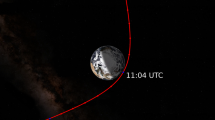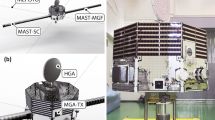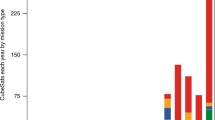Abstract
The Dawn mission journeys to the center of the main asteroid belt to orbit and explore the two most massive main belt asteroids, Vesta and Ceres. Dawn aims to increase our understanding not just of the present state of these two bodies, but also of the conditions during the time of their formation. It attempts this through achieving a set of measurement objectives in which the physical properties of these asteroids such as mass, slopes, size, density, and spin state are accurately determined, and in which the mineralogical and elemental composition of the surface and near-surface material are probed. Dawn employs ion propulsion technology to enable a modestly-sized launcher to start a moderately-sized spacecraft on its journey, to not only reach the two massive asteroids but also to orbit them, descending to near the surface. Unlike most orbital missions, the initial (Vesta) phase must be completed with sufficient reserves and within a time window that later allows Dawn to explore Ceres. Dawn carries a redundant framing camera, a visible and near-IR spectrometer, a gamma ray and neutron spectrometer, and achieves high-accuracy radiometric and optical navigation to enable gravity field determination. The spacecraft was developed by Orbital Sciences Corporation under the management of the Jet Propulsion Laboratory for the National Aeronautics and Space Administration. Dawn is a Principal Investigator-led mission of the Discovery Program. The PI institution, the University of California, Los Angeles, manages directly the science team, the Dawn Science Center, and the Education and Public Outreach program.










Similar content being viewed by others
References
J. Brophy, The Dawn ion propulsion system (2011, this issue)
A. Coradini, D. Turrini, C. Federico, G. Magni, Vesta and Ceres: crossing the history of the solar system. Earth Planet. Astrophys. (2011). doi:10.1007/s11214-011-9792-x
M.C. DeSanctis, A. Coradini, E. Ammannito, G. Filacchione, M.T. Capria, S. Fonte, G. Magni, A. Barbis, A. Bini, M. Dami, I. Ficai-Velotroni, G. Preti, V.I.R. Team, The VIR spectrometer. Space Sci. Rev. (2011). doi:10.107/s11214-010-9668-5
A. Eviatar, A. Bar-nun, M. Podolak, Europan surface phenomena, Icarus, 61, 185–191 (1985). doi:10.1006/0019-1035(85)90100-9
T.C. Fraschetti, M.D. Rayman, C.T. Russell, C.A. Raymond, Dawn discovery mission: lessons learned, in Proceedings of 6th IAA International Conference on Low-Cost Planetary Missions, Kyoto, Japan, 11–13 October 2005
A. Konopliv, S.W. Asmar, B.G. Bills, N. Mastrodemos, R.S. Park, C.A. Raymond, D.E. Smith, M.T. Zuber, The Dawn Gravity Investigation at Vesta and Ceres. Space Sci. Rev. (2011). doi:10.1007/s11214-011-9794-8
J.-Y. Li, P.C. Thomas, B. Carcich, M.J. Mutchler, L.A. McFadden, C.T. Russell, S.S. Weinstein-Weiss, M.D. Rayman, C.A. Raymond, Improved measurement of Asteroid (4) Vesta’s rotational axis orientation. Icarus 1, 528–534 (2010). doi:10.1016/j.icarus.2010.09.019
J.M. Makowski, V. Thomas, K. Nelson, T. Meyer, M. Violet, J. Williams, G.M. Brown, C. Cardoso, B. Pavri, D. Bruno, M. Chiville, D. Termohlen, The Dawn spacecraft. Space Sci. Rev. (2011, this issue)
T.B. McCord, J. Castillo-Rogez, A. Rivkin, Ceres: Its origin, evolution, and structure and Dawn’s potential contribution. Space Sci. Rev. (2011). doi:10.1007/s11214-010-9729-9
T.B. McCord, J.B. Adams, T.V. Johnson, Asteroid Vesta: spectral reflectivity and compositional implications. Science 168, 1445–1447 (1970). doi:10.1126/science.168.3938.1445
L.A. McFadden, J. Wise, J.D. Ristvey, Jr. W. Cobb, The Education and Public Outreach Program for NASA’s Dawn Mission. Space Sci. Rev. (2011). doi:10.1007/s11214-011-9840-6
H.Y. McSween, E. Ammannito, F. Capaccioni, M.T. Capria, J.-P. Combe, A. Coradini, M.C. DeSanctis, M. Farina, G. Filacchione, H. McSween, G. Magni, C. Pieters, C.A. Raymond, C.T. Russell, J.M. Sunshine, T. Titus, M.J. Toplis, D.W. Mittlefehldt, A.W. Beck, R.G. Mayne, T.J. McCoy, HED meteorites and their relationship to the geology of Vesta and the Dawn mission. Space Sci. Rev. (2011). doi:10.1007/s11214-010-9637-z
H.Y. McSween, Meteorites and Their Parent Planets (Cambridge University Press, Cambridge, 1987), p. 237
D. O’Brien, M.V. Sykes, The origin and evolution of the asteroid belt—implications for Vesta and Ceres. Space Sci. Rev. (2011). doi:10.1007/s21214-011-9808-6
C. Peebles, Asteroids: A History (Smithsonian Inst. Press, New York, 2000), p. 280
C. Pieters, L.A. McFadden, T. Prettyman, M.C. DeSanctis, T.B. McCord, T. Hiroi, R. Klima, J.-Y. Li, R. Jaumann, Surface composition of Vesta: issues and integrated approach. Space Sci. Rev. (2011). doi:10.1007/s11214-011-9809-5
C. Polanskey, S.P. Joy, C.A. Raymond, Dawn science planning operations, and archiving. Space Sci. Rev. (2011, this issue)
T.H. Prettyman, W.C. Feldman, H.Y. McSween, Jr., R.D. Dingler, D.C. Enemark, D.E. Patricl, S.A. Storms, J.S. Hendricks, J.P. Morgenthaler, K.M. Pitman, R.C. Reedy, Dawn’s gamma ray and neutron detector (2011, this issue)
M.D. Rayman, T.C. Fraschetti, C.A. Raymond, C.T. Russell, Coupling of system resource margins through the use of electric propulsion: implications in preparing for the Dawn mission to Ceres and Vesta. Acta Astronaut. 60, 930–938 (2007). doi:10.1016/j.actraastro.2006.11.012
C.A. Raymond, R. Jaumann, A. Nathues, H. Sierks, T. Roatsch, F. Preusker, F. Scholten, R. Gaskell, L. Jorda, H.-U. Keller, M. Zuber, D. Smith, N. Mastrodemos, S. Mottola, The Dawn topography investigation. Space Sci. Rev. (2011, this issue)
A. Rivkin, J.-Y. Li, R.E. Milliken, L.F. Lim, A.J. Lovell, B.E. Schmidt, L.A. McFadden, B.A. Cohen, The surface composition of Ceres. Space Sci. Rev. (2011). doi:10.1007/s11214-010-9677-4
C.T. Russell, F. Capaccioni, A. Coradini, M.C. De Sanctis, W.C. Feldman, R. Jaumann, H.U. Keller, T.B. McCord, L.A. McFadden, S. Mottola, C.M. Pieters, T.H. Prettyman, C.A. Raymond, M.V. Sykes, D.E. Smith, M.T. Zuber, Dawn mission to Vesta and Ceres: symbiosis between terrestrial observations and robotic exploration. Earth Moon Planets 101, 65–91 (2007). doi:10.1007/s11038-007-9151-9
H. Sierks, H.U. Keller, R. Jaumann, H. Michalik, T. Behnke, F. Bubenhagen, I. Buttner, U. Carsenty, U. Christensen, R. Enge, B. Fiethe, P. Guierrez Marques, H. Hartwig, H. Kruger, W. Kuhne, T. Maue, S. Mottola, A. Nathues, K.-U. Reiche, M.L. Richards, T. Roatsch, S.E. Schroder, I. Szemerey, M. Tschentscher, The Dawn framing camera. Space Sci. Rev. (2011). doi:10.1007/s11214-011-9745-4
P.C. Thomas, R.P. Binzel, M.J. Gaffey, B.H. Zellner, A.D. Storrs, E.N. Wells, Vesta: spin pole, size and shape from HST images. Icarus 128, 88–94 (1997). doi:10.1006/icar.1997.5736
R.L. Wildfang, Rome’s Vestal Virgins: A Study of Rome’s Vestal Priestesses in the Late Republic and Early Empire (Routledge, New York, 2006)
T.C. Worsfold, History of the Vestal Virgins of Rome (Rider & Co., Paternoster House, E.C., London, 1934)
M. Zuber, H. McSween, R.P. Binzel, L.T. Elkins-Tanton, A.S. Konopliv, C.M. Pieters, D.E. Smith, Origin, internal structure, and evolution of 4 Vesta. Space Sci. Rev. (2011). doi:10.1007/s11214-011-9806-8
Acknowledgements
The success of the Dawn mission is due to many individuals, not just the scientists and engineers who planned, executed, launched and have operated the spacecraft, but also those involved in the development of ion propulsion; those who sat on selection and review panels; those who helped advance the technical readiness level of the ion propulsion engine, and those who supported Dawn during its darkest days when it lost the support of its immediate sponsors in NASA. We cannot give credit in this article to all those individuals, and in fact, we do not know all their names. But those involved in the Dawn mission are grateful for the tremendous effort that was expended by so many in the implementation of this mission.
Those with whom we worked most closely include personnel from NASA’s Lewis Research Center (now Glenn), from JPL, from TRW, Orbital and their subcontractors, from NASA Headquarters, from the Discovery Program Office at NASA Marshall Space Flight Center, from Los Alamos, from the Max Planck Institute, from INAF, from DLR, from ASI and all the organizations supporting the members of the science teams deserve much thanks. We are especially grateful to the Project Managers at JPL and at the various contractors and subcontractors who were so dedicated to making Dawn a success that they put their jobs on the line to ensure it would be. Finally, we thank Robert Mase who has led the project during its operational phase since shortly after launch.
The preparation of this report was supported by the National Aeronautics and Space Administration under contract NNM05AA86C. A portion of the work was carried out at the Jet Propulsion Laboratory.
Author information
Authors and Affiliations
Corresponding author
Rights and permissions
About this article
Cite this article
Russell, C.T., Raymond, C.A. The Dawn Mission to Vesta and Ceres. Space Sci Rev 163, 3–23 (2011). https://doi.org/10.1007/s11214-011-9836-2
Received:
Accepted:
Published:
Issue Date:
DOI: https://doi.org/10.1007/s11214-011-9836-2




